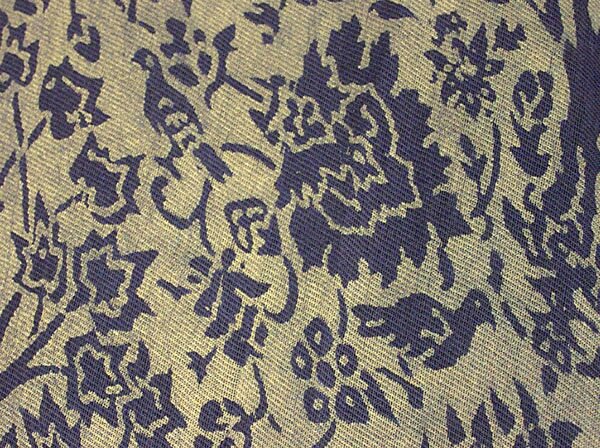Fortuny stenciled silk gauze wrap, c.1920
Fortuny stenciled silk gauze wrap, c.1920. Sold. Courtesy Vintage Textile
Mariano Fortuny created his stenciled silk gauze wraps to add ornamentation to the plain pleated Delphos gowns. I love the way the caftan-style wrap allows the body-clinging, sexy Delphos gown (or a garment of your choice) to show through.
The three-quarter length silk gauze wrap, based on antique ethnic caftan styles, is cut square with openings for the arms. The edges are trimmed with coral-colored Venetian glass beads, which give the caftan the necessary weight to hang properly. A stenciled Fortuny garment has minimal cuts so that the garment can serve as a canvas for the art work.
The hand stenciling is done with real gold metallic pigments aged to a mellow, burnished color. Fortuny built his stenciled pieces layer upon layer, until he achieved the effect of an old fresco. The stenciled pattern is Persian with birds and trees.
Fortuny's contemporaries described him as "an alchemist" because he never revealed the secret techniques employed in the atelier at his 15th-century Palazzo Orfei in Venice. He achieved magical effects by means unfathomable to outsiders.
Mariano Fortuny y Madrazo was born into a dynasty of Spanish painters in Granada in 1871 but spent most of his life in Venice. His father, Mariano Fortuny y Marsal, regarded in Spain as an outstanding 19th-century artist, died when the boy was only three.
Venice had been the center of the Renaissance textile trade with the Orient and was a rich source of ideas from ancient Persian and Islamic cultures. Inspired by antique textiles in his father's collection, Mariano Fortuny did not simply copy the designs, but reinterpreted them to achieve an aesthetic ideal.
He created some of the most remarkable fabrics and dresses of the 20th century. Although known today primarily as a dress and fabric designer, he was also a painter, etcher, sculptor, photographer, lighting engineer, set designer, theater director, inventor and architect. He personified the Renaissance man who could do it all. As a young man, he stated, "Art is my life's aim." His work is a living testament to that ideal.
Transparent Fortuny gauze pieces do not have labels. The bottom picture shows Elsie McNeil wearing a version of this wrap in 1927. She was a celebrated New York interior designer who founded Fortuny Inc. in 1927 to import his fabrics and dresses. She rescued the Fortuny textile factory from receivership during the Depression.
The condition is excellent. A rare treat in an early couture garment. One size fits all.
Elsie McNeil wearing a stenciled wrap by Fortuny, 1927. McNeil was a celebrated New York interior designer who founded Fortuny Inc. in 1927 to import his fabrics and dresses. She rescued the Fortuny textile factory from receivership during the Depression.

/https%3A%2F%2Fprofilepics.canalblog.com%2Fprofilepics%2F1%2F0%2F100183.jpg)
/https%3A%2F%2Fstorage.canalblog.com%2F03%2F02%2F119589%2F96711876_o.jpg)
/https%3A%2F%2Fstorage.canalblog.com%2F11%2F31%2F119589%2F94773502_o.jpg)
/https%3A%2F%2Fstorage.canalblog.com%2F20%2F83%2F119589%2F94772815_o.jpg)
/https%3A%2F%2Fstorage.canalblog.com%2F26%2F72%2F119589%2F75604929_o.jpg)
/https%3A%2F%2Fstorage.canalblog.com%2F59%2F60%2F119589%2F26458628_o.jpg)










/http%3A%2F%2Fstorage.canalblog.com%2F35%2F33%2F119589%2F122162097_o.jpg)
/http%3A%2F%2Fstorage.canalblog.com%2F34%2F24%2F119589%2F117579660_o.jpg)
/http%3A%2F%2Fstorage.canalblog.com%2F70%2F44%2F119589%2F111327194_o.jpg)
/http%3A%2F%2Fstorage.canalblog.com%2F69%2F42%2F119589%2F107196689_o.jpg)